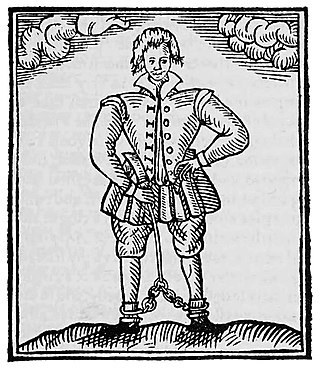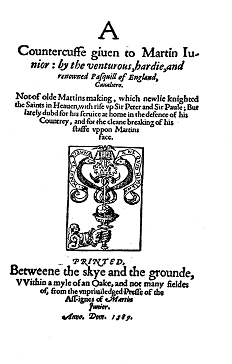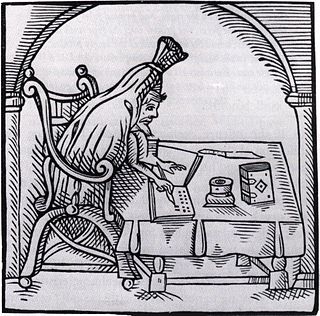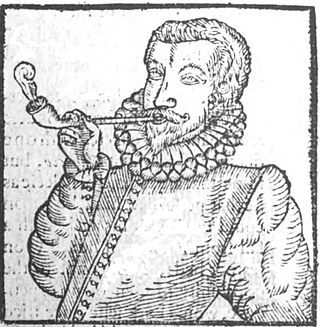Barnabe Barnes was an English poet. He is known for his Petrarchan love sonnets and for his combative personality, involving feuds with other writers and culminating in an alleged attempted murder.

Thomas Nashe was an Elizabethan playwright, poet, satirist and a significant pamphleteer. He is known for his novel The Unfortunate Traveller, his pamphlets including Pierce Penniless, and his numerous defences of the Church of England.

Martin Marprelate was the name used by the anonymous author or authors of the seven Marprelate tracts that circulated illegally in England in the years 1588 and 1589. Their principal focus was an attack on the episcopacy of the Anglican Church.

Gabriel Harvey was an English writer. Harvey was a notable scholar, whose reputation suffered from his quarrel with Thomas Nashe. Henry Morley, writing in the Fortnightly Review, has argued that Harvey's Latin works demonstrate that he was distinguished by qualities very different from the pedantry and conceit usually associated with his name.

The Marprelate Controversy was a war of pamphlets waged in England and Wales in 1588 and 1589, between a puritan writer who employed the pseudonym Martin Marprelate, and defenders of the Church of England which remained an established church.

Richard Lichfield was a barber surgeon in Cambridge, England, during the late 16th and early 17th century. In 1597 he wrote a pamphlet sharply criticising the writer Thomas Nashe, which for many years was believed to be the work of Gabriel Harvey.

Robert Greene (1558–1592) was an English author popular in his day, and now best known for a posthumous pamphlet attributed to him, Greene's Groats-Worth of Witte, bought with a million of Repentance, widely believed to contain an attack on William Shakespeare. Robert Greene was a popular Elizabethan dramatist and pamphleteer known for his negative critiques of his colleagues. He is said to have been born in Norwich. He attended Cambridge where he received a BA in 1580, and an M.A. in 1583 before moving to London, where he arguably became the first professional author in England. Greene was prolific and published in many genres including romances, plays and autobiography.
Saffron Walden Free Grammar School was a school in the Essex town of Saffron Walden, which for over four hundred years educated the boys of the town and surrounding villages in a manner designed to be after the model of Eton College and Winchester. It was notable for its longevity and for some of its illustrious alumni.
Samuel Hammond D.D. was a Church of England minister, and later a nonconformist.
Thomas Edwards was an English poet who published two Ovidian epic poems Cephalus and Procris and Narcissus. Beyond his name, nothing is known with certainty of Edwards. He has been provisionally identified with a Shropshire law student of that name who transferred from Furnival's Inn to Lincoln's Inn in June 1587, where he shared a room with a known friend of John Donne. Edwards may have contributed the Latin verse to Adriaan van Roomen's Parvum theatrum urbium, published in 1595.
Francis Mason (c.1566–1621) was an English churchman, archdeacon of Norfolk and author of Of the Consecration of the Bishops in the Church of England (1613), a defence of the Church of England and the first serious rebuttal of the Nag's Head Fable put about as denigration of Matthew Parker and Anglican orders.
Ronald Brunlees McKerrow, FBA was one of the leading bibliographers and Shakespeare scholars of the 20th century.

In theatres, beginning in Elizabethan London, a jig was a short comic drama that immediately followed a full-length play. This phenomenon added an additional comic or light-hearted offering at the end of a performance. A jig might include songs sung to popular tunes of the day, and it might feature dance, stage fighting, cross-dressing, disguisings, asides, masks, and elements of pantomime.
"Cutting" Ball was a notorious criminal during the Elizabethan Age.

Greenes, Groats-worth of Witte, bought with a million of Repentance (1592) is a tract published as the work of the Elizabethan author Robert Greene.

Anthony Chute was an English poet and pamphleteer. Very little is known about him.
The Choise of Valentines Or the Merie Ballad of Nash His Dildo, which alternatively acquired the label "Nashe's Dildo", is an erotic poem by Thomas Nashe, thought to have been composed around 1592 or 1593. The poem survives in three extant manuscript versions and was first printed in 1899. It recounts in the first person a sexual encounter in a brothel between the narrator, Tomalin, and his lover, Mistress Frances. The poem contains the most detailed description of a dildo in Renaissance literature, and contains one of the first attestations of the word dildo, though the word seems to derive ultimately from nonsense syllables common in early-modern popular ballads.
Joan Leche, benefactress, was the wife successively of Thomas Bodley, and of Thomas Bradbury, Lord Mayor of London in 1509. She founded a chantry in London, and a grammar school in Saffron Walden, Essex. Her great-grandson, Sir John Leveson (1555–1615), was instrumental in putting down the Essex rebellion of 8 February 1601, and her great-grandson William Leveson acted as trustee for the original shareholders of the Globe Theatre.

Pierce Penniless his Supplication to the Divell is a tall tale, or a prose satire, written by Thomas Nashe and published in London in 1592. It was among the most popular of the Elizabethan pamphlets. It was reprinted in 1593 and 1595, and in 1594 was translated into French. It is written from the point of view of Pierce, a man who has not met with good fortune, who now bitterly complains of the world's wickedness, and addresses his complaints to the devil. At times the identity of Pierce seems to conflate with Nashe's own. But Nashe also portrays Pierce as something of an arrogant and prodigal fool. The story is told in a style that is complex, witty, fulminating, extemporaneous, digressive, anecdotal, filled with wicked descriptions, and peppered with newly minted words and Latin phrases. The satire can be mocking and bitingly sharp, and at times Nashe’s style seems to relish its own obscurity.
Richard Harvey (1560-1630) was an English astrologer, theologian and controversialist.










